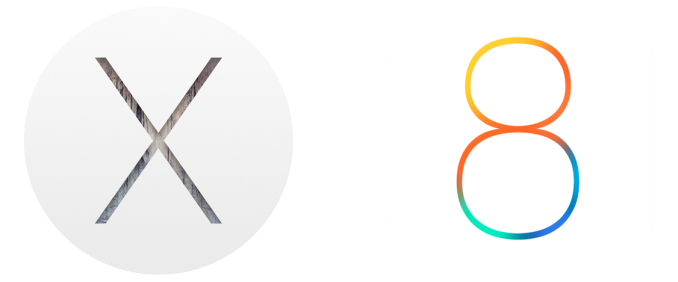A Look At OS X Yosemite And iOS 8.1
by Brandon Chester on October 27, 2014 8:00 AM EST
Introduction
It has been a busy year for Apple, although one could argue it has been more of a busy few months. The yearly updates for most of Apple's products now occur in September and October, and as a result we've seen the release of a number of new products and services in a very short period of time. On the hardware side we have the new iPhone 6 and 6 Plus, the iPad Air 2 and Mini 3, the iMac with Retina 5K display, and a preview of the upcoming Apple Watch. The software side has arguably been even more exciting with the release of iOS 8 and its first major update iOS 8.1, OS X Yosemite, and Apple Pay.
The theme this year appears to be integration and the power of a software and hardware ecosystem. Apple has always had some level of integration between iOS and OS X. As time went on, both operating systems began to share a core set of applications like Reminders, Calendar, and Notes. The iPad extended this even further by bringing the iWork and iLife suites to mobile. iCloud also played a key role in integrating both systems, by synchronizing documents and photos between all of a user's devices. However, the launch of iOS 7 with its visual and functional enhancements left many of the shared features and applications on OS X feeling left behind.
OS X Yosemite brings with it a massive visual overhaul, on a scale even greater than what we saw with iOS 7. This makes sense, as OS X is an operating system for desktops and laptops which makes it inherently more expansive and complex than iOS. Although OS X is not nearly as popular as iOS in terms of user base, the fact that the redesign changes some visual elements that have existed for over 14 years makes it quite a monumental moment in Apple's history. These changes finally unify the visual styles of both operating systems, which were once united but split with the launch of iOS 7.
The integration of these two operating systems goes far beyond a common type of visual design. OS X Yosemite and iOS 8.1 also include new features that allow them to work together in unprecedented ways. Features like Handoff blur the borders between the iPhone, the Mac, and the iPad by allowing you to continue work you began on one device on another. SMS and call forwarding takes communication abilities that were typically reserved for the iPhone and brings them to every device.
There's a lot to talk about, and it all begins at the aesthetic level with the new design of Yosemite.










173 Comments
View All Comments
monopodman - Wednesday, October 29, 2014 - link
"Apple doesn't build that because they treat their consumers as if they were idiots"Apple has to sell their computers to masses, and most people are..... idiots. If you're not satisfied with the current OS X, it probably won't get better in future. There's a reason you can still build a custom computer up to your own liking.
SirPerro - Monday, October 27, 2014 - link
But that's part of their business right? Selling support to their customers and having their hardware hot-glued and soldered so that the average joe cannot remove a couple of screws and change the ram for free.It's so fucking annoying I consider the non retina MBP the last Apple product worth buying. Everthing else is a no-go.
III-V - Monday, October 27, 2014 - link
"Selling support to their customers and having their hardware hot-glued and soldered so that the average joe cannot remove a couple of screws and change the ram for free."That's not why they do it, or why anyone else does it, for that matter. I'm not going to bother enlightening you, because it seems like I'd be wasting my time.
sjprg2 - Monday, October 27, 2014 - link
You can enlighten both of us. Apple is a greedy XXX.darwinosx - Monday, October 27, 2014 - link
Unfortunately for you Apple's products aren't any more expensive than their counterparts unless you count $600 Best Buy laptops.wetwareinterface - Monday, October 27, 2014 - link
$1999 macbook pro retina 15"iris graphics, 16GB ram, 256 solid state, 2.2 quad i7, aluminum shell, retina display
$1399 lenovo y50
nvidia gtx 860m, 16Gb ram, 256 solid state, 2.4 quad i7, carbon fiber shell, 4k display
$1499 toshiba Satellite P55T-B5262
radeon 265x, 12Gb ram, 1Tb hard drive, 2.4 quad i7, aluminum shell, blu ray burner, 4k display
apple's products are more expensive, and they give you less for that higher price
malarc - Monday, October 27, 2014 - link
comparing MBP to y50 on hardware spec alone is a quite unfair. i don't think there's any carbon fiber on the y50 and the overall quality does not compare - even though apple's seen better days. is it worth 600$? apparently quite a lot of people think so -- not everybody has a use for a gaming laptop.Buk Lau - Wednesday, October 29, 2014 - link
mind defining overall quality please?techconc - Tuesday, October 28, 2014 - link
Tell me more about the costs you've factored in for malware protection and for OS upgrades. The same goes for office productivity software, etc, etc. Tell me about the battery life (hint - only 4hrs. 10min playing video), etc., etc.Buk Lau - Wednesday, October 29, 2014 - link
malware protection? freeOS upgrades? win 8.1 pre-installed and win 10 is most likely a cheap upgrade if not free for existing win 8 users. battery life? I'm sorry it's just very sad that you can't find a power plug within 4 hours